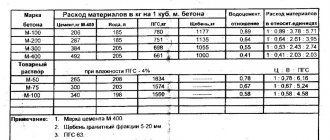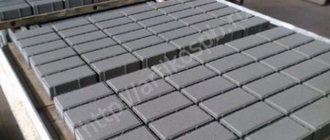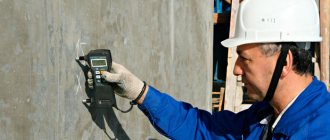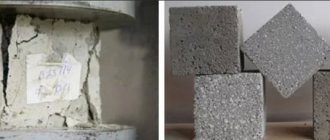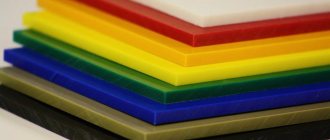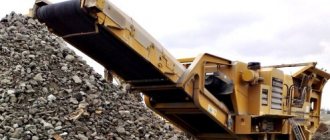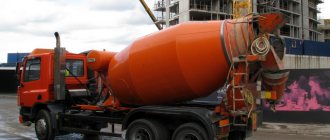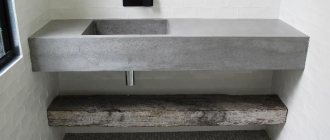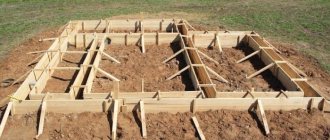Concrete processing and its main tasks
Due to prolonged exposure of concrete to variable temperatures, precipitation, exhaust gases, and dust, its gradual destruction occurs. Dirty and damaged concrete must be restored. When restoring (sanitizing) concrete, it is cleaned, that is, contaminated and damaged layers are removed , and the concrete surface is given the necessary roughness for the subsequent application of a protective or decorative coating.
At the moment, the treatment of concrete surfaces is widely used for the purpose of cleaning them from cement film (cement laitance). Modern building codes require the mandatory removal of this film from concrete bases and working joints on horizontal and inclined surfaces. Vertical surfaces must be cleared of cement film if there are corresponding requirements in the project.
The cause of concrete destruction can also be various violations of construction technologies and the natural processes that take place in the concrete itself.
Cement laitance is a product that is released from the water-cement mixture after it is laid. It forms a film on the concrete surface , which prevents the monolithic connection of the decorative coating and the base, which significantly reduces the strength of the structure.
Reasons for the formation of cement film:
- composition of cement . Cement contains alkalis to a lesser or greater extent. After mixing cement and water, an aqueous solution of calcium hydroxide is formed, which, when it reaches the surface, reacts with carbon dioxide present in the air and forms a poorly soluble layer of calcium carbonate on the concrete screed;
- incorrect ratio of water and cement in the concrete mixture. After laying and compacting this mixture, it delaminates, that is, heavier components (sand, crushed stone) fall down, and lighter components (water and binders) are forced up. As a result, a dirty white suspension forms on the surface of the screed - a layer of cement laitance. It should be noted that cement laitance is formed even with the correct ratio of cement and water, but only in smaller quantities, that is, the layer will be very thin.
The cement film is removed using mechanical or chemical action . The essence of mechanical methods is that a layer of cement laitance is scraped off the concrete surface with various tools or abrasives. In the chemical method, special acid solutions are used.
Laitance must be removed for:
- reliable adhesion of the concrete base and contact finishing coating (paint, varnish, liquid waterproofing). When applying polymer coatings to a concrete surface with the cement film not removed, a three-layer structure is obtained: the “body” of the screed – a layer of cement laitance – the finishing coating. The polymer coating does not bond to a strong concrete screed, but to a fragile crust of cement laitance with a low level of adhesion. As a result, the finishing coating peels off along with a layer of cement laitance from the concrete base;
- greater strength of the finishing structure (concrete surface and coating). The surface cement film, located between the finishing coating and the “body” of concrete, is the “weakest link”. Internal stresses arising during operation of such a structure lead to the destruction of the weak layer, so it must be removed.
Methods for protecting concrete from corrosion
They imply two types of protection - protection of reinforcement and embedded parts and protection of the concrete stone itself.
This protection is further divided according to GOST into primary and secondary.
Primary protection involves preparatory and survey work at the design stage, taking into account the aggressiveness of the environments in which reinforced concrete structures will be used. This preparation involves the selection of concrete mixture compositions with the necessary plasticity, workability and a number of other technical measures.
Secondary protection is carried out when during operation the shortcomings of the primary protection are revealed or they prove to be insufficient.
Protecting reinforced concrete reinforcement frames from corrosion involves the main method - a sufficient thickness of the protective layer of concrete and maintaining it in working order for the entire period of operation of the structure.
You can also additionally include the use of plasticizing additives as protective measures, which participate indirectly in creating a dense protective layer and thereby reduce the water-cement ratio.
It is also beneficial to use concretes with a low content of substances that promote corrosion, such as chlorides. Corrosion inhibitors also serve as a sufficient obstacle to curbing the corrosion processes of reinforcing steel.
By adding them to concrete, the electrochemical reactivity of steel changes, for example, cathode inhibitors. A number of chemical compositions make it possible to create a protective layer already on the surface of the reinforcement, for example, calcium bicarbonate salt.
The use of protective measures for concrete is widespread. Let's look at it in order:
- Hydrophobization.
This is the use of special additives in concrete that do not allow the surfaces of structures to be wetted with water and thereby prevent aggressive liquid media from penetrating into the lower layers of concrete. These mainly include compositions with organosilicon content. These substances create a water-repellent effect due to the formation of a thin film on the surface of concrete based on the silicon-oxygen siloxine bond. They are prepared by dissolving them in solvents or aqueous emulsions. Due to its low viscosity, this composition penetrates deep into the body of the concrete stone to a depth of 10 mm. Compositions such as methyl silicates and sodium ethyl silicates (GKZh-10 and GKZh-11) are used. Hydrophobizing polyethylhydrosiloxane (GKZh-94) is also used.
- Paint and varnish coatings.
To protect concrete and reinforced concrete from aggressive environments (gases and liquids), their surfaces are treated and painted. This procedure largely depends on the porosity of the surface. If it is significant, then additional work has to be carried out - priming the surface and even puttying . The concrete surface must be free of grease stains and dust. If necessary, treat with solvent. The advantages of such procedures include paint fastness, accessibility for complex configurations, and repairability. The disadvantage will be a short service life.
- Rolled adhesive insulation.
This is a very common type of protection for concrete surfaces. There are also polyethylene films and waterproofing materials, brisols, roofing felts . Rolled materials are glued to the surfaces of reinforced concrete structures using epoxy-rubber adhesives. This waterproofing reliably protects concrete from corrosion. Their choice is very wide in modern construction.
- Biocidal additives.
When constructing livestock buildings, food or structures where microorganisms, fungi, and mold can develop, it is necessary to introduce biocidal additives . These additives will not allow microorganisms and mold to develop on the surface. For protection at the stage of preparing concrete mixtures, the following are mixed: bactericidal - against bacteria, fungicidal - against fungi, algaecidal - against algae. They come in solid, liquid and gaseous forms (fumigants).
Concrete processing methods
A properly prepared concrete surface is a necessary condition for the quality of subsequent work when performing many construction and finishing operations.
Such preparation is carried out when necessary:
- clean the concrete surface before applying protective and any other special compounds (waterproofing, anti-corrosion, water-repellent, etc.);
- remove old paint from concrete;
- clean concrete surfaces from traces of fire;
- prepare a concrete base for self-leveling floors.
Concrete is also processed to obtain the necessary roughness of the concrete surface for applying decorative or any other coating.
Treatment of concrete surfaces is carried out using chemical and mechanical methods. With the chemical method, surface treatment is carried out with 5-10% solutions of hydrochloric or acetic acid , as well as other ready-made special chemicals. After the chemical solution reacts with cement laitance or contaminants on the concrete surface, wash it off with a copious stream of water.
Mechanical treatment of a concrete surface allows you to get rid of a wide variety of contaminants and defects. After mechanical treatment, old concrete surfaces are freed from weak and cracked top layers, and new ones are freed from cement laitance and various irregularities. In addition to cleaning, the surface acquires the necessary degree of adhesion to paints, primers and plasters .
The main mechanical methods are:
- grinding;
- milling;
- sandblasting;
- shot blasting.
Mechanical cleaning is not recommended before applying some types of waterproofing materials. In this case, they resort to waterjet cleaning of concrete.
For this type of cleaning, a stream of water with an abrasive is used, which is applied to the concrete surface under high pressure. The use of high pressure water does not affect the structure of concrete and its modulus of elasticity .
The disadvantage of this method is the opening of concrete pores only in the surface layer. It should also be noted that there are restrictions on the use of this technology in existing industries and residential premises.
Type II concrete corrosion
Scientists describe the destruction of this type of concrete from the effects of salts and acids from the environment on the surface layers of concrete structures when they enter into complex chemical reactions. By destroying the top layer of cement stone, the aggressive environment washes it away and exposes a fresh layer, which is also subject to aggression and is mechanically washed away. Thus, type II concrete undergoes corrosion layer by layer until its complete destruction. The speed of this process can be different and depends on how long the collapsing layer will remain and protect the inner layers from the aggressive environment.
It is necessary to note the effect of carbon dioxide (H2CO3) in this process. Depending on the amount of its content in natural reservoirs, this effect will differ in different environments. The acidity of the environment will be dangerous for concrete with an index value of more than 5.7. By interacting with the components of cement stone, carbon dioxide creates new formations that lose their astringent properties and are washed out by water, causing damage to the concrete stone. We will not dwell in more detail on other salts and acids; the main thing is to understand that they act on the same principle.
Concrete grinding
In most cases, the concrete surface acts as the base for industrial floors, so it must be absolutely level, smooth and clean. This can be achieved by grinding. Modern concrete grinding technologies make it possible to create a reliable and practical coating that does not require special care and has excellent moisture resistance and inertness to chemically aggressive environments.
Sanded floors, due to their quality characteristics, can be used both in various indoor spaces and in open areas for various purposes.
Concrete grinding can be done wet or dry, depending on the type of base. Wet grinding is used mainly for mosaic surfaces. In this case, a tool with larger abrasive grains is used than in dry grinding.
After wet grinding is completed, the concrete surface must be thoroughly dried before proceeding with further operations.
Dry grinding is a rather dusty and time-consuming process, but it guarantees a higher quality of processing of the concrete base . To reduce dust formation using the dry method, special industrial vacuum cleaners are used. After this sanding, you can immediately begin installing the finishing coatings.
Grinding a concrete floor is carried out in two stages. The first time is 5-7 days after pouring the concrete mixture, and the second time is after the mixture has completely hardened.
At the first stage, grinding is performed primarily to remove the fragile layer of cement laitance. This stage cannot be skipped, since a weak surface, devoid of any fillers, will begin to dust and collapse at the slightest load. The coating on such a screed will not stick at all - it will peel off along with the cement laitance.
Final grinding of the concrete screed is carried out in the following order:
- Concrete condition assessment . If necessary, all cracks should be sealed with epoxy mastic.
- Removing reinforcement protruding from concrete. It is carefully cut with a grinder.
- Applying a strengthening compound to close the pores in the monolith. If the concrete base will be polished after grinding, then the impregnation is applied immediately before this stage.
- The actual grinding with discs of different grain sizes until the surface of the required quality is obtained. After completion of the work, the concrete floor is cleaned of dust and covered with the selected protective composition.
After grinding, the old concrete floor is freed from cracked and weak top layers and returns to its original properties. The new screed is leveled in order to obtain a high quality usable surface that does not require complex finishing.
In both cases, the cost of maintaining decorative coatings is reduced, and their wear resistance increases. That is, a one-time investment in concrete grinding ensures its long service life without major repairs . Sometimes such treatment is the only way to remove old, stubborn dirt or peeling layers from a concrete surface.
A high-quality polished concrete screed takes on a very decent appearance after applying a thin layer of paint or varnish. This is quite enough to ensure that the concrete floor does not require special care and remains strong and durable in any conditions. After removing the weak surface layer, the concrete surface acquires high levels of adhesion, strength and density (water resistance).
Components of Rigid Concrete
- Cement. For the production of rigid concrete, Portland cement grade M400 or M500 is used. When mixed with water, it acts as a binder to bind large and small components of the mixture. The cement must be fresh to create quality concrete.
- Sand. This component plays the role of a fine aggregate that fills voids and ensures hardening of the mixture. Usually they take fine river or quarry sand. It is sifted and washed, since impurities of clay and dust and dirt have a bad effect on the quality of the mixture.
- Crushed stone. For rigid concrete, gravel or stone crushed stone of large and small fractions is used. It is cleaned of foreign matter by sifting.
- Water. This component should not contain foreign impurities. If the water is not sufficiently read, it is first passed through a purification system. When interacting with cement, a hydration reaction occurs, and subsequently, concrete hardening.
- Supplements Special chemicals that increase the characteristics of the mixture - plasticizers, sealants, antiseptics, water repellents.
Self-production
This type of concrete, unlike other higher grades, can be prepared independently at the construction site.
To do this, you need to prepare and measure the ingredients. The dry ingredients are mixed together, and then water is poured in and brought to a homogeneous consistency. You can mix by hand, but to make the process easier, it is better to use a concrete mixer. He copes with the task more thoroughly and quickly.
Hard concrete hardens very quickly, so it is more advisable to prepare it locally and use it immediately. If you ordered the mixture from a specialized enterprise, it must be delivered to the site as quickly as possible and installation can begin immediately.
Areas of application of rigid concrete
- Floor screed.
- Landscaping of territories (paths, platforms).
- The basis for laying roads.
- Subfloor when pouring the foundation.
- Base for a bowl when building swimming pools.
Rigid concrete is not very strong and is prone to cracking. But there are undoubted advantages to using it. It is economical, used in almost all types of rough work, it is easy to prepare on site, and the filler can be replaced with industrial waste.
produces and sells concrete mixtures of various classes and brands. It's easy to place an order with us. Call the manager of our company. He will help you place your order and calculate the cost including delivery.
Milling concrete surfaces
Milling ensures the preparation of concrete surfaces in residential and industrial construction. This operation helps to easily dismantle old coatings in parking lots, bridges, and runways.
Milling is used for rough removal of the top layers of concrete, when it is necessary to remove unevenness and differences from the concrete surface, as well as to clean it from heavy contamination with fuels and lubricants. The concrete surface after milling turns out to be relatively rough, and therefore requires further processing with a mosaic grinder.
Milling is used for:
- removing the top weak layer of concrete coating up to 3-5 mm thick;
- removal of old polymer coatings;
- creating grooves on the concrete surface that provide an anti-slip effect;
- leveling the floor for subsequent installation of parquet, laminate and other decorative coatings.
Low-quality cement-sand screeds up to 10 mm thick are removed by milling
Milling of concrete is carried out by two types of machines:
- rotary, on which drums (bush hammers) with lamellas (stars) are installed. When the drum rotates, the lamellas bite into the concrete and remove the unnecessary layer;
- disk The cutting tools of these machines are also lamellas, but they are mounted not on a drum, but on a disk (traverse).
The technology for milling concrete surfaces involves the use of two machines. First, a pass is made with a milling machine, and then a mosaic grinder is used to remove all the irregularities. If the required result cannot be achieved in one go, then the operations are repeated, that is, again, first use a milling machine, and then a grinding machine.
Sandblasting of concrete surfaces
Sandblasting is considered one of the most effective and high-quality ways to clean concrete from various contaminants. With its help, you can remove dirt and cement laitance from the concrete surface and prepare it for the application of a protective, waterproofing or decorative coating.
This technology is very simple. Abrasive particles (sand, nickel slag, cooper slag) hit the surface with force under the influence of a high-pressure air flow and remove contaminants. Sandblasting is usually used where other methods are ineffective , for example, to clean curved and hard-to-reach surfaces from long-standing and complex types of contamination.
Sandblasting is a very popular technology and is used for a variety of purposes:
- cleaning of metal tanks and pipes in the petrochemical and engineering industries to extend their service life or subsequently apply any coating;
- cleaning building facades before applying putty, decorative plaster, as well as for the purpose of disinfection and removal of various biological organisms;
- cleaning surfaces with special requirements (helicopters, cars, boats) using soft abrasive materials - starch, plastic, etc.;
- cleaning wooden surfaces;
- processing of glass surfaces for decorative purposes;
- treatment of hydraulic structures, bridges and roads.
Processing of concrete and other surfaces occurs with the help of abrasive particles, which are accelerated in a sandblasting unit due to the energy of compressed air. Any sandblasting installation consists of three main components: a compressor, a blasting apparatus and an abrasive . The required processing result is ensured by the ability to adjust the flow of compressed air, which disperses the abrasive particles. To perform sandblasting efficiently, you need professional equipment, a high level of skill and strict control of the work performed.
The sandblasting method was invented almost 150 years ago - in 1870. At that time, quartz sand was used as an abrasive, which was washed and sifted through special sieves to achieve uniformity of the material. But the use of quartz sand had an adverse effect on the health of workers, as it led to silicosis , a severe incurable disease associated with damage to the respiratory tract by silica sand dust.
Today, sandblasting technology has evolved and acquired many varieties.
Instead of quartz sand, glass beads, corundum powder, nickel slag and other materials with less hazardous components are used.
Types of modern sandblasting:
- gas dynamic cleaning . With this cleaning method, abrasive materials are in a jet stream and accelerate to 300 m/s (for a better understanding: this is the speed of a bullet fired from a gun);
- hydro jetting . When using this method, a stream of water with an abrasive is used for cleaning, which is applied to the surface to be treated under a pressure of 10-750 MPa. Dirt at this pressure disappears from the surface almost instantly;
- cleaning with dry ice . "Dry ice" is carbon dioxide. This substance at room temperature goes directly into the vapor state, skipping the liquid phase.
Using sandblasting, fairly large areas of concrete surfaces that have lost their performance characteristics can be easily removed. This method is used to clean concrete walls, columns, staircase porticos, balustrades, etc.
Sandblasting copes well with contaminants of various origins:
- efflorescence on facades;
- remnants of old cement mortar;
- rusty streaks and rust itself;
- glue stains;
- fungal formations;
- graffiti and paint marks.
For small-scale work, ejector sandblasting guns are usually used, the main advantages of which are compactness, lightness, ease of use, and affordable price. To treat large areas, pressure-type sandblasting units are used.
The productivity of the installation is selected depending on the scale of work and the possibility of placing equipment on site. It should be borne in mind that the performance indicators of a sandblasting installation depend, first of all, on the technical characteristics of the compressor used, so its selection should also be given great attention.
Concrete mix survivability - concrete survivability time
The survivability of a concrete mixture is a characteristic that determines how long the concrete will retain its performance characteristics.
This parameter is central in the process of determining moments of interaction with the client. A drop in mobility of no more than 30% is allowed. If it decreases beyond this parameter, it is considered that the mixture has gone beyond its norms. Its use is not recommended as it may cause adverse effects. If we consider other material parameters, they should not decrease.
The concrete's life time comes to an end when it sets. This is a special process that occurs inside each concrete mixture. It involves the start of a chemical reaction between water and the binder material. During its course, reliable bonds are formed between particles, which will only become stronger in the future. If at this moment you start moving the train, they will easily collapse. In this case, even after re-hardening, the characteristics will no longer be as high as they could have been initially.
To determine the survivability time of concrete, it is common to use several methods. As practice shows, it is about two hours, but may vary depending on some external factors.
Vitality of concrete mixture - influencing factors
- Brand of mixture. This factor has a serious impact for one simple reason, namely the presence of a binder. The more cement in the composition, the faster its hardening will occur. Thus, the survival time is reduced for high grades, which must be taken into account during their transportation.
- Ambient temperature. As is known, all reactions slow down somewhat at low temperatures and accelerate when exposed to high temperatures. All this is typical for concrete. In hot weather, the rate of onset of setting increases, and in cold weather there is about an additional hour.
- Use of special additives. There are hardening accelerators and retarders on this market, providing different effects from their use. Our company is ready to use any of these additives, if necessary. More detailed information is discussed with the customer.
In general, it is the durability of concrete that determines the range of its transportation. When a dump truck is used, this period is somewhat reduced due to the lack of movement of the train along the way. This accelerates not only setting, but also delamination, which occurs much faster. The use of a mixer is preferable because it continuously mixes the concrete. The movement prevents him from losing his parameters for some time. Additionally, the specified mobility is maintained.
b25.ru
Shot blasting of concrete
The principle of shot blasting is based on the mechanical action of solid abrasive particles on the concrete surface, which receive kinetic energy from a high-speed air flow. As a result of this treatment, a clean surface with a high level of adhesion is obtained.
The speed at which abrasive particles are applied to the surface being treated allows it to be effectively removed from various deposits, layers of paint, and areas with a weak surface layer. In this case, hard and dense areas of the concrete surface experience virtually no mechanical impact. Any coating (primer, paint) or rust can be removed from metal elements present on the surface of reinforced concrete structures using shot blasting.
The main feature of the impact of shot is a significant increase in the surface strength of the concrete base . The main difference from many other concrete processing methods is the deeper penetration of the abrasive material into shrinkage cracks and other weak spots on the surface of the structure.
However, shot blasting cannot be used:
- in the presence of a polymer-based self-leveling coating with a thickness of more than 5 mm;
- for removing toppings;
- to remove contaminants from all kinds of mineral compounds of viscoplastic consistency.
Shot blasting will not cope with oil and oil contamination of concrete
Shot blasting can be used on both freshly laid concrete and older concrete substrates . In the first case, it is used to remove cement laitance, and in the second, various contaminants and damaged areas. During shot blasting, thanks to the use of powerful industrial vacuum cleaners equipped with automatically cleaning filter elements, there is virtually no dust emission into the air.
Despite all its advantages, shot blasting is characterized by a fairly high cost due to the high wear and tear of the working elements of the equipment. After 5-8 thousand square meters of the treated surface, it is necessary to completely change the centrifuges, sealing collars and carbide plates of the shot ejection and receiving chamber.
The principle of operation of a shot blasting unit is as follows: the abrasive material moves along a special hose thanks to a compressor. When leaving the nozzle, the abrasive has a very high speed, so when it hits the surface being treated, it transfers a fairly large amount of kinetic energy to it . As a result, a large number of tiny cracks form on the coating to be removed, contributing to its destruction and subsequent removal.
Choice of abrasive
To obtain a high-quality cleaning result, the choice of abrasive is very important. If you choose an abrasive that is not intended for performing any type of work, then even the best equipment cannot guarantee a high-quality result.
For abrasive blasting of concrete, abrasive materials are used:
- natural origin;
- industrial origin;
- made from by-products.
Abrasives of natural origin are sand, garnet, zirconium, flint and other minerals. Industrial abrasives include those that are manufactured specifically for blasting equipment. These are crushed and cast shot, aluminum oxide, silicon carbide, plastic, glass beads, wheat starch and others.
By-product abrasives are the result of manufacturing processes. These materials include slags obtained from metal smelting or electrical energy production, as well as materials from processed agricultural products used in the food industry.
The selection of the appropriate fraction of abrasive granules is very important. To remove the remains of cement mortar or several layers of old paint, large abrasive granules are used, which leave a deep profile on the surface. The use of medium-sized granules allows you to effectively remove rust, loose paint or a thin layer of scale from the surface. The small granules are ideal for processing sensitive materials such as wood and plastic.
Many manufactured abrasives can be used repeatedly. This also applies to natural abrasives such as flint and granite chips. The most stable is steel shot . It has the least fragility and can withstand at least 200 cycles. The ability to recover abrasive depends on many variables, including surface hardness, air pressure and equipment efficiency.
Chemical carbonization processes
The operation of concrete and reinforced concrete structures in the air is accompanied by the influence of acid gases on the material. Since carbon dioxide usually has a higher concentration than other compounds, its effect is particularly pronounced. So, what is carbonization of concrete? This is a process of neutralization of porous material, during which carbon dioxide, oxygen and moisture contained in the air are absorbed. How active the carbonization process will be depends on both the concrete itself and the characteristics of the aggressive environment. The key factor is the CO2 concentration, which varies on average from 500 to 6000 mg/m3. Structures with metal reinforcement during carbonization and against the background of close contact with an acidic environment begin to corrode, as a result of which rust progresses.
In its pure form, concrete is also subject to negative carbonization processes. Carbon dioxide interacts with clinker minerals and cement stone. Even a small percentage of CO2 in the air triggers concrete neutralization reactions. The carbonation that occurs during the reaction of acid with calcium hydroxide depends on air humidity, porosity and permeability of the material, pressure and temperature. Ultimately, such processes leave hydration products with a wide range of by-products in the form of alumina, hydrated silica and iron oxide in the case of metal structures.
Chemical treatment of concrete
Chemical milling is also suitable for cleaning brick structures
In recent years, in domestic construction, a fundamentally new method of preparing concrete surfaces for the application of waterproofing materials, which is called “chemical milling,” has become widespread.
This method has proven to be equally effective in removing cement laitance from both old and fresh, wet and dry, porous and dense concrete surfaces.
When chemical milling, special two-component compounds are used . The use of the first component allows you to dissolve efflorescence and non-hydrated cement. With the help of the second component, the remnants of the first composition are neutralized and the surface of the cement stone is activated, which increases its adhesion by 10-15%.
The technology of chemical treatment of concrete is used to remove cement film before applying waterproofing compounds, before creating cut-off waterproofing, installing self-leveling floors, as well as to eliminate “cold joints” and during many other processes that require high-quality adhesion of concrete to the applied compound.
Advantages of chemical treatment of concrete:
- dissolution and removal of cement laitance without destroying the cement stone;
- effective elimination of the “cold seam”;
- increasing the depth of penetration of penetrating waterproofing materials into concrete;
- increase by 1.5-2 times the adhesion of coatings of a wide variety of chemical natures;
- exclusion of manual machining, machine milling and grinding, sand-, shot-, and water-abresive blasting;
- reducing the labor intensity and cost of concrete cleaning work.
What time of year to concrete
Let's discuss the nuances of work under different weather and temperature values:
- Summer period. On cool summer days (June or August), work with cement mortar is carried out at the lowest possible cost if the following conditions are met: temperatures within +17-25 ℃ and air humidity within 80%. These temperatures must be maintained for two weeks to ensure the best hardening of the solution. If there is an increase of 30℃ or higher, cracks may appear on the surface. In rainy weather, it is necessary not to allow the base to flood with water - it is worth protecting the surface with polyethylene, especially during the setting period of the mixture.
- Spring-autumn period. In the second half of spring and September, at stable warm temperatures, without frost, concrete work can be carried out without danger. In case of frost, it is recommended to introduce special antifreeze additives into the mixture.
- Winter period. This is the most expensive period for concrete pouring processes. The cost of work may increase by 35-40%. Concreting is carried out at temperatures not lower than -15 ℃, with mandatory recommended conditions to protect the bases from freezing. It is better to entrust such work to specialists.
Based on all of the above, it follows that the best and cheapest period for foundation construction work is the last month of spring and the first month of summer.
Concrete processing tools
The quality of processing of concrete surfaces largely depends on the tool used. At the moment, advanced tools based on synthetic and natural diamonds are especially widely used for mechanical processing of concrete . The conducted studies prove that performing mechanical processing of concrete using diamond tools reduces the cost of these operations by 2-2.5 times compared to conventional abrasive tools and increases the productivity of the process by 1.5-3 times.
Diamond technologies represent a fundamentally new approach to the problems of processing a wide variety of materials. The secret lies in the high resistance of diamond grains to mechanical wear. These grains, fixed on the cutting surface of the tool, make it possible to easily make openings of any shape and holes of the desired diameter with maximum accuracy.
In addition, a tool with diamond segments allows cutting, drilling or grinding concrete very quickly , which increases the productivity of the work performed several times, and without vibration and a large amount of dust.
A diamond tool with such unsurpassed performance characteristics was destined for success from the very beginning. Very soon after the triumphant appearance of this tool on the market, it began to be actively used in a variety of areas of human activity.
At the moment, diamond tools are used to solve most typical problems that arise during the repair and construction of buildings for both industrial and civil purposes, as well as during the installation of reinforced concrete building structures, the construction of airfields, subways, nuclear power plants, hydraulic structures, etc.
Each specific tool has its own specific purpose, its own specifics and technical features.
Modern manufacturers offer a very wide selection of diamond tools. The market offers a wide variety of diamond grinding and cutting discs, drills, Frankfurts, cutters, crowns, ropes, dry cutters and much more. Such a wide variety of diamond tools is associated with their active use in a variety of areas of construction. However, the variety of shapes and types does not affect the essence: the structure of diamond tools remains identical in any case.
Any diamond tool consists of a metal body and a diamond-bearing layer deposited on its surface. It is the diamond-bearing layer that is the functional basis of the tool, since it interacts with the material being processed.
This layer is a binder consisting in a certain proportion of diamond grains and metal powder. As a rule, synthetic diamonds are used for diamond tools , which are not inferior in hardness to natural ones, but are much cheaper.
The efficiency and quality of work of a diamond tool depend on how well the composition of the binder is selected. There is no exact recipe for making a bond, so manufacturers experiment to try to develop the ideal bond formula for a particular instrument.
Much attention is paid to achieving an optimal balance between the work of diamond granules and the resistance of the material being processed. It is very important that the diamond grains are held together until the entire resource is used up and new crystals are released . The quality of the segment should remain unchanged.
Each material has a certain degree of abrasiveness and hardness. Depending on this, a tool with a harder or softer bond should be selected. For harder materials, choose a tool with a soft bond and, conversely, for abrasive materials I choose a hard bond. This ratio allows you to operate the tool for as long as possible, avoiding premature loss of diamond granules from the bundle.
When choosing a diamond tool, you should also pay attention to its service life and performance . Resource is measured in square meters, and productivity is measured in square centimeters per minute. Both parameters depend on the characteristics of the material being processed and operating conditions.
General information about carbonation
A sharp decrease in the reliability of concrete structures can be associated with various factors, most of which are associated with unfavorable environmental conditions. Carbonization is one of the key reasons why not only the destruction of the outer protective layers of concrete structures occurs, but also deep-seated deformation processes. The most dangerous consequences include cracking and peeling, as well as the creation of conditions for the development of corrosion. The latter applies to reinforced concrete structures that have traditional steel reinforcement rather than fiberglass in their structure.
Depending on the characteristics of the air environment, destruction processes may appear already in the first months of operation. Therefore, it is so important to take timely measures to protect structures. This area of research is regulated by GOST. Carbonization of concrete is given attention in document 31384-2008, dedicated to the protection of building structures from corrosion. In particular, a description is given of two interrelated characteristics - durability and the permissible depth of damage to the structure. At the same time, there are diagnostic problems due to the difficulties of accurately predicting the parameters of an aggressive environment. Difficulties arise when analyzing temperature and humidity conditions and the degree of CO2 concentration.
Security measures
A mandatory condition for maintaining safety when carrying out work on processing concrete surfaces is to clear the work area from various foreign objects (garbage, building materials, unused mechanisms). When machining, it is necessary to exclude any possibility of any metal objects getting into the working area of the cutting tool, which could cause failure of quite expensive equipment.
Machines with an electric drive must be connected to the electrical network only through protective switching devices using a plug connection with a protective grounding contact. The serviceability of this device must be checked before connecting the machine. During work, care must be taken to ensure that dust and moisture do not enter the circuit breaker or plug connection . In the event that the disconnecting device is triggered, it can be re-enabled only after the damage in the equipment used has been repaired.
Conducting wires should be protected from friction against sharp corners or objects, from sharp bends, and should not be allowed to twist or come into contact with heated surfaces. When moving the machine along the surface being treated, it is necessary to ensure that various foreign objects do not fall under its wheels and working parts.
You cannot work with the machine even if cracks have appeared in the body elements or the fastening of the working parts has become loose.
It is not allowed to work with machines when lubricant is leaking from the drive, when the switches are not working properly, or when there is vibration, increased noise, or a smell characteristic of burnt insulating materials.
Before starting work, be sure to check:
- serviceability of the grounding device to which the machine will be connected;
- integrity of the grounding wire and grounding circuit;
- no short circuits to the body;
- serviceability of power cable insulation;
- correct connection of the neutral wire;
- tightening of threaded connections.
Since mechanical processing generates a lot of dust, which poses a health hazard, workers must use special protective equipment : long-sleeved clothing made of thick fabric, closed shoes, goggles with a mask, canvas mittens, and earplugs.
When working with chemical compounds, you should avoid inhaling the vapors of these compounds, as well as getting them on the skin and eyes. The workplace should be well ventilated.
Cost of work
The cost of concrete processing services is influenced by factors such as the initial condition of the concrete surface, its strength, the type of equipment and consumables used, as well as the volume of work performed.
Estimated cost of services for treating concrete surfaces:
| Name of works | Cost, rub/sq. meter |
| Milling of concrete aged from 28 days with removal of a layer up to 4 mm thick | From 500 |
| Milling of concrete aged from 28 days with removal of a layer more than 4 mm thick and with intermediate grinding | From 650 |
| Pre-grinding | From 180 |
| Final sanding | From 140 |
| Sandblasting concrete | From 220 |
conclusions
The most common way to prepare a concrete surface for the application of a protective, waterproofing or decorative coating is grinding. This method can be used both for young concrete and for concrete that has been in use for more than one year. Shot blasting and sandblasting are also highly effective, but due to bulky and rather expensive equipment, the use of these methods is not always advisable.
Among the variety of concrete processing methods, diamond milling and grinding are undoubtedly the leaders.
It should also be taken into account that when processing concrete with various abrasives, too much secondary waste and dust is generated . Therefore, from the point of view of labor safety, fire and environmental safety, the use of waterjet cleaning is more effective. When using chemical treatment, it is necessary to use only proven chemical compositions, strictly monitoring their concentration and consumption, since there is a risk of removing not only a layer of cement laitance, but also damaging the “body” of the concrete itself.
All stages of diamond processing technology for concrete surfaces are shown in the video:
Concrete composition
Concrete is a complex material consisting of several components. By the way, compositions reminiscent of modern concrete were used by the builders of Ancient Rome. Modern manufacturers, for example, the Baltic Beton plant, use more complex technologies, but the general composition is almost always the same:
- Cement;
- Filler in the form of sand or crushed stone;
- Water;
- Additives and additives that provide various specific properties of the solution (increased plasticity, frost resistance, etc.).
The most suspect components in concrete from a safety point of view are cement and additives. However, we immediately note that both cement and additives are in a bound state in the solution, which excludes their chemical interaction with the environment (adjusted for slow corrosion, of course).
